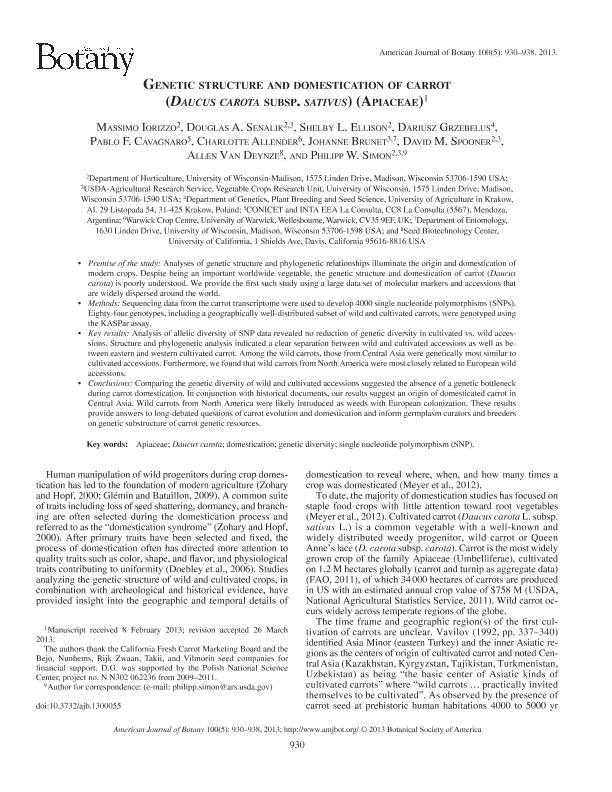Mostrar el registro sencillo del ítem
dc.contributor.author
Iorizzo, Massimo
dc.contributor.author
Senalik, Douglas A.
dc.contributor.author
Ellison, Shelby L.
dc.contributor.author
Grzebelus, Dariusz
dc.contributor.author
Cavagnaro, Pablo Federico

dc.contributor.author
Allender, Charlotte
dc.contributor.author
Brunet, Johanne
dc.contributor.author
Spooner, David M.
dc.contributor.author
Van Deynze, Allen
dc.contributor.author
Simon, Phillip W.
dc.date.available
2016-09-06T15:32:21Z
dc.date.issued
2013-05
dc.identifier.citation
Iorizzo, Massimo; Senalik, Douglas A.; Ellison, Shelby L.; Grzebelus, Dariusz; Cavagnaro, Pablo Federico; et al.; Genetic structure and domestication of carrot (Daucus carota subsp. sativus L.) (Apiaceae); Botanical Society of America; American Journal Of Botany; 100; 5; 5-2013; 930-938
dc.identifier.issn
0002-9122
dc.identifier.uri
http://hdl.handle.net/11336/7476
dc.description.abstract
Premise of the study: Analyses of genetic structure and phylogenetic relationships illuminate the origin and domestication of modern crops. Despite being an important worldwide vegetable, the genetic structure and domestication of carrot ( Daucus carota ) is poorly understood. We provide the fi rst such study using a large data set of molecular markers and accessions that are widely dispersed around the world.<br />• Methods: Sequencing data from the carrot transcriptome were used to develop 4000 single nucleotide polymorphisms (SNPs). Eighty-four genotypes, including a geographically well-distributed subset of wild and cultivated carrots, were genotyped using the KASPar assay.<br />• Key results: Analysis of allelic diversity of SNP data revealed no reduction of genetic diversity in cultivated vs. wild accessions. Structure and phylogenetic analysis indicated a clear separation between wild and cultivated accessions as well as between eastern and western cultivated carrot. Among the wild carrots, those from Central Asia were genetically most similar to cultivated accessions. Furthermore, we found that wild carrots from North America were most closely related to European wild accessions.<br />• Conclusions: Comparing the genetic diversity of wild and cultivated accessions suggested the absence of a genetic bottleneck during carrot domestication. In conjunction with historical documents, our results suggest an origin of domesticated carrot in Central Asia. Wild carrots from North America were likely introduced as weeds with European colonization. These results provide answers to long-debated questions of carrot evolution and domestication and inform germplasm curators and breeders on genetic substructure of carrot genetic resources.
dc.format
application/pdf
dc.language.iso
eng
dc.publisher
Botanical Society of America

dc.rights
info:eu-repo/semantics/openAccess
dc.rights.uri
https://creativecommons.org/licenses/by-nc-sa/2.5/ar/
dc.subject
Apiaceae
dc.subject
Domestication
dc.subject
Genetic Diversity
dc.subject
Single Nucleotide Polymorphism (Snp)
dc.subject
Daucus Carota
dc.subject.classification
Ciencias de las Plantas, Botánica

dc.subject.classification
Ciencias Biológicas

dc.subject.classification
CIENCIAS NATURALES Y EXACTAS

dc.title
Genetic structure and domestication of carrot (Daucus carota subsp. sativus L.) (Apiaceae)
dc.type
info:eu-repo/semantics/article
dc.type
info:ar-repo/semantics/artículo
dc.type
info:eu-repo/semantics/publishedVersion
dc.date.updated
2015-10-15T19:43:10Z
dc.journal.volume
100
dc.journal.number
5
dc.journal.pagination
930-938
dc.journal.pais
Estados Unidos

dc.journal.ciudad
St. Louis
dc.description.fil
Fil: Iorizzo, Massimo. University of Wisconsin. Department of Horticulture; Estados Unidos
dc.description.fil
Fil: Senalik, Douglas A.. University of Wisconsin. Department of Horticulture; Estados Unidos. United States Department Of Agriculture. Agriculture Research Service; Vegetable Crops Research Unit; Estados Unidos
dc.description.fil
Fil: Ellison, Shelby L.. University of Wisconsin. Department of Horticulture; Estados Unidos
dc.description.fil
Fil: Grzebelus, Dariusz. University of Agriculture in Krakow. Department of Genetics, Plant Breeding and Seed Science; Polonia
dc.description.fil
Fil: Cavagnaro, Pablo Federico. Consejo Nacional de Investigaciones Científicas y Técnicas. Centro Científico Tecnológico Mendoza; Argentina. Instituto Nacional de Tecnología Agropecuaria. Centro Regional Cuyo Mendoza-San Juan. Estación Experimental Agropecuaria La Consulta; Argentina
dc.description.fil
Fil: Allender, Charlotte. University of Warwick. Warwick Crop Centre; Reino Unido
dc.description.fil
Fil: Brunet, Johanne. United States Department Of Agriculture. Agriculture Research Service; Vegetable Crops Research Unit; Estados Unidos. University of Wisconsin. Department of Entomology; Estados Unidos
dc.description.fil
Fil: Spooner, David M.. University of Wisconsin. Department of Horticulture; Estados Unidos. United States Department Of Agriculture. Agriculture Research Service; Vegetable Crops Research Unit; Estados Unidos
dc.description.fil
Fil: Van Deynze, Allen. University of California. Seed Biotechnology Center
; Estados Unidos
dc.description.fil
Fil: Simon, Phillip W.. University of Wisconsin. Department of Horticulture; Estados Unidos. United States Department Of Agriculture. Agriculture Research Service; Vegetable Crops Research Unit; Estados Unidos
dc.journal.title
American Journal Of Botany

dc.relation.alternativeid
info:eu-repo/semantics/altIdentifier/url/http://www.amjbot.org/content/100/5/930
dc.relation.alternativeid
info:eu-repo/semantics/altIdentifier/doi/http://dx.doi.org/10.3732/ajb.1300055
Archivos asociados
